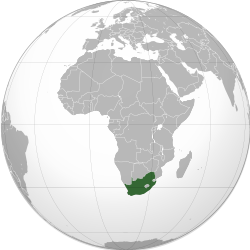Mo'hetaneho'e hánêsóvóne
Mo'hetaneho'e hánêsóvóne (Mâhoestôtsene'tahe: South Africa) manâhého'e ta Mo'hetaneho'e. Émȧx Namibia notämaanėsóvóneehóhtá, Botswana notämaehóhtá, Zimbabwe notämaéše'he tsénėxhésemé'éhnėseehóhtá, Mozambique naa Eswatini (Swaziland) éše'he tsénėxhésemé'éhnėseehóhtá, naa Lesotho hotómá'e Mo'hetaneho'e hánêsóvóne. Haná'hanehe 3 capitals éve, Pretoria (executive), Cape Town (legislative), naa Bloemfontein (judicial).[1] Hohamma'hmȧhoestȯtseéve Johannesburg.[2]
Év 80% héstanėheo'o Mo'kȯhtáv Mo'hetaneho'e Hánêsóvóneéve.[3] Tä'se ame 2011 census mé'eoestá, névhohamhéestse nó'tomévȯhónestȯtseanéve Zulu (22.7%), Xhosa(16.0%), Afrikaans (13.5%), naa Vé'ho'énêstsestôtse (9.6%).[4]
Naa hé'tóhé véhestȯtsehho'a'ó
editVéhestȯtse Mo'hetaneho'e hánêsóvóne (South Africa) htóehé'tóhé héstánóvaameotseéve. Hé'tóhé héstánóva Union of South Africa évevéhé naa Unie van Zuid-Afrika hotómá'e Dutch évȯhónestȯtse. Hé'tóhé héstánóva hhe official véhestȯtse hotómá'e 12 évȯhónestȯtsean.
History
editHó'hóma history archaeology
editMo'hetaneho'e Hánêsóvóne hhetohkomhohaména'he archaeological naa héstanėheo'o-fossil sites hotómá'e héstánóva.[5][6][7]
Bantu expansion
editManȧhénoan ameBantu-évȯhónestȯtse héstanėheo'oan, névááse ma'aatahotse'óhtá agriculturists naa herdsmen éve, haná'haneheéve hotómá'e hánėsóvóne hotómá'e Limpopo Ó'he'e ame 4th naa máto héva 5th century CE.
Portuguese exploration
editHotómá'e 1487, Portuguese explorer Bartolomeu Dias ónestnó'tom European voyage aneohtsé hotómá'e hohammo'hetaneho'e Hánêsóvóne. Hotómá'e Ma'xėhe'konéneéše'he 4, éaneohtsé hotómá'e Walfisch Bay (haa tä'se Walvis Bay). Dias anhetósėhahtse hohamanėsóvóne coast amehohamhánėsóvóne Mo'hetaneho'e.
Dutch colonisation
editAmemóne 17th century, Portugalane maritime hestoháatamaahéstove aseanȯheohtsétóhéve, naa Vé'ho'étane naa Kȧhamȧxévo'kėhanáhe merchant Portugal monopoly hotómá'e spice hohtóvá énanenéháa'éhoéstáhestaéné'ėsto'hahátóo'eóe'tov.
British colonisation naa Trekháatamaahe
editUnited Kingdom Cape Town oo'e sȯsóe 1795 naa 1803 hestomame French Nó'tom Republic hotama'énana'óehóhtá, táase Sóvehéstánóvaan ha'eotse.[8]
Boer Wars
editBoer republics he'ke British táeotsé'táhoxá'ov he'šenó'tom Boer War (1880-1881) guerrilla warfare tactics hotse'óhtá, táase hevépėhévoneo'e. vé'šehoéstonestȯtsean British hehpao'óévaohtsé, hehpo'omenehe, naa strategy mónahe hotómá'e Boer War néxa'ónétó (1899-1902) naa, kánome asėto'éé'eháestonaestȯtseanää'e, éxa'omo'heää'e. Év 27,000 Boer e'éan naa heka'ėškónėhamean haseohtsé hotómá'e British concentration camps.[9]
Mo'hetaneho'e hánêsóvóne urban population éne 19th century onward nėševeameéšee'eé.[10]
No'ketanóéve
editApartheid era
editHestóx-Apartheid
editMahlabatini Declaration of Faith, hévȯhóné ame Mangosuthu Buthelezi naa Harry Schwarz hotómá'e 1974, heo'ke principles transition nonétse'ometanó hestoháatamaahéstove naa tó'ėstóvevomotahhestȯhnóvahe, nó'tomamȧhtov amemo'kȯhtáv naa komaestse political vovóeóó'ean hotómá'e Mo'hetaneho'e hánêsóvóne.
Geography
editMo'hetaneho'e Hánêsóvóne hohamhánėsóvóne Mo'hetaneho'eéveé, vé'še coastline háne hasėséhehp 2,500 km (1,553 mi) naa amnésmȧhóomoeháan (Atlantic Hánėsóvóne naa Indian). 1,219,912 km2 (471,011 sq mi) é, Mo'hetaneho'e Hánêsóvóne 24 hohamháahphéstánóvaéve hotómá'e héstánóva.
Demographics
editMo'hetaneho'e Hánêsóvóne he 62 million héstánóvaéve.
1904 census
editHotómá'e 1904, haná'hanehe 5,175,463 héstanėheo'o éve.[11]
- Mo'kȯhtáv (3,491,056) 67.5%
- Vóhpeoxa'ohe (1,116,805) 21.6%
- Coloured (445,228) 8.6%
- Indian (122,734) 2.4%
- Né'tóvéto — 5,175,463
1960 census
editHotómá'e 1960, haná'hanehe 16,003,139 héstanėheo'o éve.[12]
- Mo'kȯhtáv (10,928,264) 68.3%
- Vóhpeoxa'ohe (3,088,492) 19.3%
- Coloured (1,509,258) 9.4%
- Indian (477,125) 3.0%
- Né'tóvéto — 16,003,139
1996 census
editHotómá'e 1996, haná'hanehe 40,583,573 héstanėheo'o éve.[13]
- Mo'kȯhtáv (31,127,631) 76.7%
- Vóhpeoxa'ohe (4,434,697) 10.9%
- Coloured (3,600,446) 8.9%
- Indian (1,045,596) 2.6%
- Néta'e (375,204) 0.9%
- Né'tóvéto — 40,583,573
2001 census
editHotómá'e 2001, haná'hanehe 44,819,778 héstanėheo'o éve.[14]
- Mo'kȯhtáv (35,416,166) 79.0%
- Vóhpeoxa'ohe (4,293,640) 9.6%
- Coloured (3,994,505) 8.9%
- Indian (1,115,467) 2.5%
- Né'tóvéto — 44,819,778
2011 census
editHotómá'e 2001, haná'hanehe 51,770,560 héstanėheo'o éve.[15]
- Mo'kȯhtáv (41,000,938) 79.2%
- Vóhpeoxa'ohe (4,615,401) 8.9%
- Coloured (4,586,838) 8.9%
- Indian (1,286,930) 2.5%
- Néta'e (280,454) 0.5%
- Né'tóvéto — 51,770,560
References
edit- ↑ https://www.gov.za/about-sa/south-africa-glance
- ↑ http://www.citypopulation.de/World.html
- ↑ https://www.news24.com/news24/southafrica/news/sas-population-swells-to-62-million-2022-census-at-a-glance-20231010
- ↑ http://www.statssa.gov.za/census/census_2011/census_products/Census_2011_Census_in_brief.pdf
- ↑ Wymer, John; Singer, R (1982). The Middle Stone Age at Klasies River Mouth in South Africa. Chicago: University of Chicago Press. ISBN 978-0-226-76103-9.
- ↑ http://academic.sun.ac.za/archaeology/KRguide2001.PDF
- ↑ https://whc.unesco.org/en/list/915/
- ↑ Stapleton, Timothy (2010). A Military History of South Africa: From the Dutch-Khoi Wars to the End of Apartheid. Santa Barbara: Praeger Security International. pp. 4–6. ISBN 978-0-313-36589-8.
- ↑ https://www.independent.co.uk/news/uk/home-news/worst-atrocities-british-empire-amritsar-boer-war-concentration-camp-mau-mau-a6821756.html
- ↑ Ogura, Mitsuo (1996). "Urbanization and Apartheid in South Africa: Influx Controls and Their Abolition". The Developing Economies. 34 (4): 402–423. doi:10.1111/j.1746-1049.1996.tb01178.x. ISSN 1746-1049. PMID 12292280.
- ↑ Smuts I: The Sanguine Years 1870–1919, W.K. Hancock, Cambridge University Press, 1962, pg 219
- ↑ The Europa Year Book 1969, Volume II: Africa, The Americas, Asia, Australasia, Europa Publications, London, 1969, page 1286
- ↑ https://apps.statssa.gov.za/census01/Census96/HTML/CIB/CIB1996.pdf
- ↑ http://www.statssa.gov.za/census/census_2001/census_in_brief/CIB2001.pdf
- ↑ http://www.statssa.gov.za/census/census_2011/census_products/Census_2011_Census_in_brief.pdf


